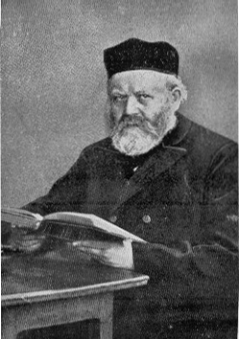R. David Zvi Hoffmann
This page is a stub.
Please contact us if you would like to assist in its development.
Please contact us if you would like to assist in its development.
 | |
| Name | R. David Zvi Hoffmann ר' דוד צבי הופמן |
|---|---|
| Dates | 1843-1921 |
| Location | Hungary / Germany |
| Works | Commentaries on Bereshit, Shemot, Vayikra, Devarim, ספר מלמד להועיל, ראיות מכריעות נגד ולהויזן |
| Exegetical Characteristics | Relationship between peshat and derash, Responds to source criticism |
| Influenced by | R. Azriel Hildesheimer, Maharam Schick, R. S.R. Hirsch, R. Y.D. Bamberger |
| Impacted on | |
Background
Life
- R. David Zvi Hoffmann was born in Verbo, Hungary, in 1843.
- He studied under R. Moshe Schick and R. Azriel Hildesheimer.
- R. Hoffmann wrote his doctorate on Mar Shemuel at the University of Tubingen.
- He taught in the rabbinical school in Hochberg and then in R. S"R Hirsch's school.
- In 1873, R. Azriel Hildesheimer founded his rabbinical school in Berlin and invited R. D"Z Hoffmann to join the faculty and teach Talmud, Halakhah, and Tanakh.
- Upon R. Hildesheimer's death, R. Hoffmann became the head of the Seminary. He served in this position until his death in 1921.1
Works
- Biblical commentaries
- Commentaries on Bereshit, Shemot, Vayikra, Devarim – R. D"Z Hoffmann wrote a commentary on Sefer Vayikra based on his lectures from 1873-1874 and 1876-1877. He began writing his commentary on Devarim but died in the middle. His commentaries on Bereshit, Shemot, and Devarim were edited by others posthumously, based on his (German) lecture notes.
- The Main Arguments Against the Graf-Wellhausen Hypothesis (ראיות מכריעות נגד ולהויזן) – R. D"Z Hoffmann's work against biblical criticism published in 1904 (in German).
- Rabbinics –
- Talmudic novellae –
- Halakhic codes –
- Responses to the works of others –
- Responsa – Melammed LeHoil (ספר מלמד להועיל) – A collection of R. D"Z Hoffmann's responsa and novellae, published posthumously from his notebooks.
- Jewish thought –
Torah Commentary
Combats the Documentary Hypothesis
- Proofs that the Torah was written in the time of Moshe – details in the Torah that would be illogical if the Torah was written later.
- Laws whose formulations match life in the desert but not life in the land of Israel – Bereshit 23:2, Bereshit 12:1 (p. 205), Introduction to Vayikra pp. 11-13, Devarim 17:16 (p. 332).
- Extra details that would be unlikely for an author to remember a few hundred years after the fact when they are no longer relevant – Introduction to Vayikra (pp. 12-13), Introduction to Vayikra 8-10 (pp. 189-190).
- Explanations of stylistic or content differences – R. D"Z Hoffmann explains that these are a result of context:
- Contradictions – Bereshit 3:22-24 (p. 91), Devarim 1:22.
- Names of God – Bereshit 2:4, Bereshit 22:10-12.
- Names of Yaakov – Bereshit 35:22, 37:3.
Responds to Textual Criticism
R. D"Z Hoffmann argues for the complete fidelity of the Masoretic Text – Introduction to Vayikra (pp. 7-8).
- Keri ukhetiv (קרי וכתיב) – Both the keri and the ketiv originate from the time that Tanakh was written – Introduction to Vayikra (p. 7).
- Primacy of the Masoretic Text over other versions – Bereshit 5:3-5, Bereshit 11:10-26.
Relationship between peshat and derash
He attempts to reconcile differences between peshat and Midrash Halakhah, but does not feel bound by Midrash Aggadah.
- כתוב שלישי – Introduction to Vayikra pp. 3-4.
- אסמכתא – Sometimes the stated Rabbinic source is just a textual hint, but the Midrash is not claiming that this is the plain meaning of the verse.
- דיבר הכתוב בהווה – The simple meaning of the verse is the meaning for the generation of the wilderness, but Rabbinic law translates the law to make it applicable for future generations – Shemot 22:30, Devarim 12:8-14, Devarim 13:7-12, Devarim 14:21.
Broad scope
He presents a broad scope analysis of Torah, starting from the book as a whole and breaking it down into pieces.
- Introductions – He introduces the book as a whole and then gives separate introductions for each section.
- Structure
- Order
Science
He relates to apparent contradictions between science and Torah – Bereshit 2:1-2, Bereshit 5:3-5.
Characteristics
- Verse by verse / Topical –
- Genre –
- Structure –
- Language –
- Peshat and derash –
Methods
- –
Themes
- –
Textual Issues
- Manuscripts –
- Printings –
- Textual layers –
Sources
Significant Influences
- Earlier Sources –
- Teachers – R. Moshe Schick, R. Azriel Hildesheimer, R. S.R. Hirsch, R. Y.D. Bamberger
- Foils –